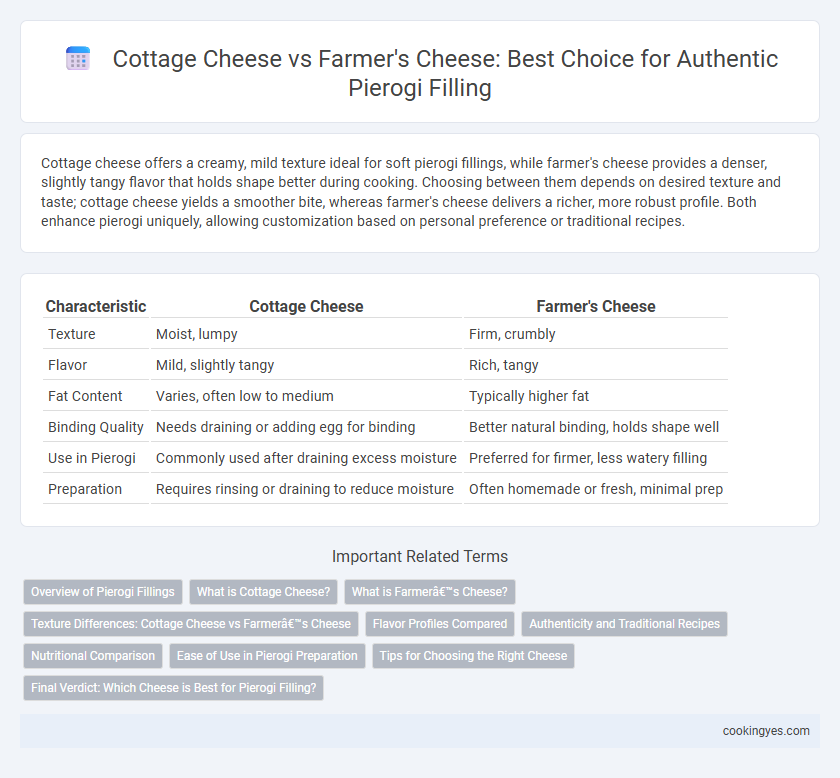Cottage cheese offers a creamy, mild texture ideal for soft pierogi fillings, while farmer's cheese provides a denser, slightly tangy flavor that holds shape better during cooking. Choosing between them depends on desired texture and taste; cottage cheese yields a smoother bite, whereas farmer's cheese delivers a richer, more robust profile. Both enhance pierogi uniquely, allowing customization based on personal preference or traditional recipes.
Table of Comparison
| Characteristic | Cottage Cheese | Farmer's Cheese |
|---|---|---|
| Texture | Moist, lumpy | Firm, crumbly |
| Flavor | Mild, slightly tangy | Rich, tangy |
| Fat Content | Varies, often low to medium | Typically higher fat |
| Binding Quality | Needs draining or adding egg for binding | Better natural binding, holds shape well |
| Use in Pierogi | Commonly used after draining excess moisture | Preferred for firmer, less watery filling |
| Preparation | Requires rinsing or draining to reduce moisture | Often homemade or fresh, minimal prep |
Overview of Pierogi Fillings
Pierogi fillings vary widely, with cottage cheese and farmer's cheese as popular bases offering distinct textures and flavors. Cottage cheese provides a creamy, slightly lumpy consistency, ideal for softer, milder pierogi, while farmer's cheese delivers a denser, crumbly texture with a tangier taste, enhancing traditional recipes. Choosing between these cheeses impacts the pierogi's authenticity and overall mouthfeel, making the selection crucial for regional variations and personal preference.
What is Cottage Cheese?
Cottage cheese is a fresh, mild-flavored cheese made from curds of pasteurized milk, characterized by its creamy texture and small curd size. It contains higher moisture content compared to farmer's cheese, making it softer and less dense for pierogi filling. This moisture level affects the final texture, resulting in a lighter and more delicate pierogi interior.
What is Farmer’s Cheese?
Farmer's cheese is a fresh, unripened cheese made by curdling milk with an acid or rennet, resulting in a crumbly texture ideal for pierogi filling. Unlike cottage cheese, farmer's cheese is pressed to remove excess whey, producing a denser consistency that holds its shape better during cooking. Its mild, tangy flavor enhances traditional pierogi recipes, offering a firm yet creamy filling distinct from the wetter, curd-heavy cottage cheese.
Texture Differences: Cottage Cheese vs Farmer’s Cheese
Cottage cheese has a creamy, moist texture with distinct curds that provide a slightly lumpy consistency ideal for lighter pierogi fillings. Farmer's cheese offers a firmer, drier texture with a crumbly, dense quality that holds shape better during cooking, resulting in a heartier pierogi. The choice between cottage cheese and farmer's cheese significantly affects the mouthfeel and structural integrity of pierogi fillings.
Flavor Profiles Compared
Cottage cheese offers a mild, slightly tangy flavor with a creamy texture, making it a popular choice for pierogi fillings that require a subtle dairy taste. Farmer's cheese delivers a richer, tangier profile with a firmer consistency, which intensifies the savory depth and provides a more robust mouthfeel. Choosing between these cheeses depends on whether a lighter or more pronounced flavor and texture are desired in the pierogi.
Authenticity and Traditional Recipes
Cottage cheese and Farmer's cheese both play distinct roles in authentic pierogi fillings, with Farmer's cheese being traditionally preferred for its firmer texture and tangier flavor that complements classic Polish recipes. Authentic pierogi recipes often emphasize Farmer's cheese due to its crumbly consistency, which holds up well during boiling and frying, maintaining the pierogi's structural integrity. While Cottage cheese offers a milder taste and softer texture, it can alter the traditional flavor profile and is less common in traditional Polish culinary practices.
Nutritional Comparison
Cottage cheese and farmer's cheese vary significantly in nutritional content for pierogi filling, with cottage cheese offering higher moisture and lower fat, typically containing around 80 calories and 4 grams of protein per 100 grams. Farmer's cheese is denser and richer, providing approximately 120 calories, 8 grams of protein, and higher calcium levels per 100 grams, making it a more nutrient-dense option. Choosing between the two depends on dietary goals, with cottage cheese favoring lower fat intake and farmer's cheese supporting higher protein and calcium consumption.
Ease of Use in Pierogi Preparation
Cottage cheese offers a smoother texture and higher moisture content, making it easier to blend into pierogi dough and achieve a creamy filling consistency. Farmer's cheese, being drier and firmer, requires crumbling and sometimes added moisture, which can slightly complicate preparation but results in a denser, tangier filling. The ease of use in pierogi preparation typically favors cottage cheese for beginners or quick recipes, while farmer's cheese suits traditional methods seeking authentic flavor.
Tips for Choosing the Right Cheese
Selecting the ideal cheese for pierogi filling hinges on texture and moisture content; cottage cheese offers a creamier, wetter consistency, while farmer's cheese provides a firmer, drier texture that holds shape better during cooking. Opt for full-fat varieties to ensure rich flavor and prevent the filling from becoming too watery. When possible, choose fresh, high-quality cheeses and drain excess liquid from cottage cheese to achieve the perfect balance for authentic pierogi.
Final Verdict: Which Cheese is Best for Pierogi Filling?
Cottage cheese offers a creamy texture with a mild flavor, making it suitable for a softer pierogi filling, while farmer's cheese provides a denser, tangier taste that holds well during cooking. For traditional pierogi, farmer's cheese is often preferred due to its ability to maintain firmness and impart authentic flavor. The final verdict favors farmer's cheese as the best option for a classic, well-textured pierogi filling.
Cottage cheese vs Farmer's cheese for Pierogi filling Infographic

 cookingyes.com
cookingyes.com